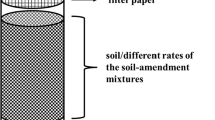Abstract
Several nitrate containing anionic clays were synthesized at different temperatures and the kinetics of NO3 − release were determined to test their suitability as slow-release N fertilizers. A sample (Mg:Al = 2:1) synthesized at 60°C with smaller particle size released 75, 86 and 100% of its NO3 − in 1, 3 and 7 days, respectively when equilibrated with a simulated soil solution. On the other hand, the 175°C/2 hrs sample with larger particle size released 65, 77 and 84% of its nitrate in 1, 3 and 7 days, respectively. Another anionic clay (synthesized at 175°C/24 hrs) of higher charge density (Mg:Al = 2:1) containing NO3 − was equilibrated with a 0.012 N NaCl or Na2CO3 to test the role of different anions in releasing the NO3 − anion from the interlayers. The results showed that Cl− released more NO3 − than did CO3 2− from this anionic clay after all the treatment times probably as a result of the CO3 2− anion blocking the release of NO3 − from the interior of the crystals. When a lower charge density (Mg:Al = 3:1) sample (synthesized at 175°C/48 hrs) was equilibrated with 0.02N solution of anions the release of nitrate was as follows: Cl− < F− < SO4 = ≤ CO3 2−. These results suggest that the divalent SO4 = and CO3 2− anions are more effective in the release of NO3 − from this lower charge density anionic clay. Time-resolved structural analysis of NO3 − exchange with CO3 2− in the above anionic clay using synchrotron x-ray diffraction showed that ion exchange is rapid because of small crystal size and lower charge density. Thus the release of NO3 − from anionic clays is an interplay among the type of anions present in soil solution, their concentration, pH of soil solution, the charge density and crystal size of anionic clay etc.
Similar content being viewed by others
References
J.K. Bartz and R.L. Jones, Soil Science Society of America Journal 47, 259 (1983).
T.M. Lai and D. Eberl, Zeolites 6, 129 (1986).
G.A. Ferguson, I.L. Pepper, and W. R. Kneebone, Agronomy Journal 78, 1095 (1986).
G.A. Ferguson and I.L. Pepper, Soil Science Society of America Journal 51, 231 (1987).
E.R. Allen, L.R. Hossner, D.W. Ming, and D.L. Henninger, Soil Science Society of America Journal 57, 1368 (1993).
M. Park and S. Komarneni, Zeolites 18, 171 (1997).
M. Park and S. Komarneni, Soil Science Society of America Journal 62, 1455 (1998).
D.L. Bish, Bulletin of Mineralogy 103, 170 (1980).
F. Cavani, F. Trifiro, and A. Vaccari, Catalysis Today 11, 173 (1991).
A. de Roy, C. Forano, K. El Malki, and J.P. Besse, Anionic clays: Trends in pillaring chemistry in Expanded Clays and Other Microporous Solids, edited by M.L. Occelli and H.E. Robson (Van Nostrand Reinhold, New York, 1992), p. 108.
J. Olanrewaju, B.L. Newalkar, C. Mancino, and S. Komarneni, Materials Letters 45, 307 (2000).
S. Miyata, Clays and Clay Minerals 23, 369 (1975).
K.A. Karrado, A. Kostapapas, and S. L. Suib, Solid State Ionics 26, 77 (1988).
N.S. Kurnakov and V.V. Chernykh, Zapiski Rossiysk Mineralogy Obshch 55, 118 (1926).
S. Miyata, Clays and Clay Minerals 31, 369 (1983).
L.M. Parker, N.B. Milestone, and R.H. Newman, Industrial Engineering Chemistry Research 34, 1196 (1995).
Y. You, G.F. Vance, and H. Zhao, Applied Clay Science 20, 13 (2001).
D.E. Baker, Soil Science Society of America proceedings 37, 537 (1973).
Y. Lee, B.A. Reisner, J.C. Hanson, G.A. Jones, J.B. Parise, D.R. Corbin, B.H. Toby, A. Freitag, and J.Z. Larese, Journal of Physical Chemistry B 105, 7188 (2001).
M. Gregorkiewitz, M. and J.A. Rausell-Colom, American Mineralogist 72, 515 (1987).
S. Komarneni and R. Roy, Science 239, 1286 (1988).
Author information
Authors and Affiliations
Rights and permissions
About this article
Cite this article
Komarneni, S., Newalkar, B.L., Li, D. et al. Anionic Clays as Potential Slow-Release Fertilizers: Nitrate Ion Exchange. Journal of Porous Materials 10, 243–248 (2003). https://doi.org/10.1023/B:JOPO.0000011385.19108.49
Issue Date:
DOI: https://doi.org/10.1023/B:JOPO.0000011385.19108.49




